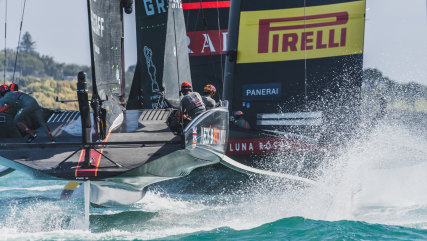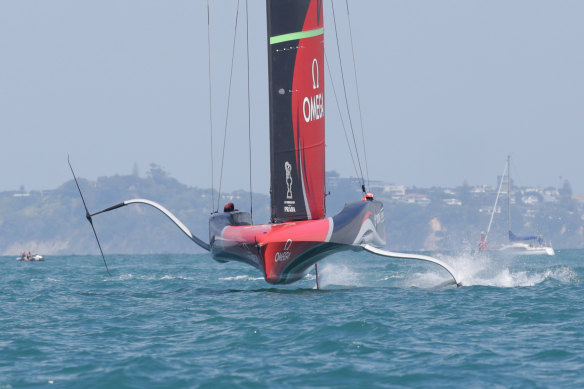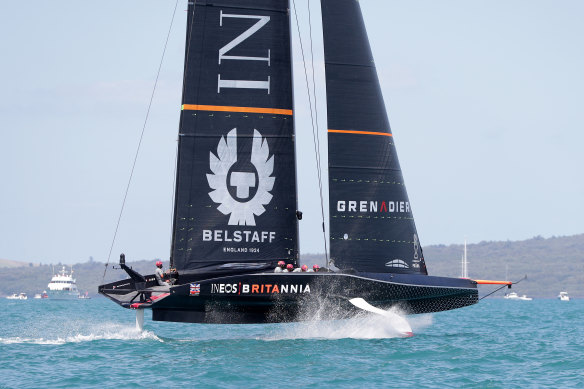- Sport
- Sailing
- Super yachts
This was published 3 years ago
Is it a boat, is it a plane? How the America's Cup is turning into an air race
If, like many Australians, your interest in the America's Cup peaked with Australia II's win in 1983, you may not recognise the race while tuning in this year.
The 36th America's Cup got under way off Auckland this week with three challengers - teams from the UK, Italy and the US - competing in a challenger series for the right to race against defending champions Team New Zealand for the Auld Mug in March.
Thanks to the rapid advancement in technology, these boats are now standing up in the water taller than ever and looks more like an air race this year rather than one contested in the water. Credit: The America's Cup
The last America's Cup was held in 2017, meaning each team has now had over three years to work on tactics, speed and, most importantly, the yachts.
Thanks to the rapid advancement in technology, primarily the use of 'foils', modern yachts in the America's Cup now spend more time in the air than they do on water. Indeed, it's not unusual on a windy day for boats to hit speeds nudging 100 km/h, and for the hull of the yacht to stay bone dry as it sits high above the water.
It is as much an air race as a sailing race.
How has the sport changed since Australia's glory days?
Australian sailing great Iain Murray is the 2021 America's Cup regatta director, and he puts it simply when asked how the sport has changed since the 1980s.
"It's a different sport," Murray told the Herald and the Age from Auckland Harbour.
Innovation has always been a part of the America's Cup; few can forget the hue and cry about the winged keel of Australia II when it was lifted out of the water after the 1983 victory.
But in the past decade, the evolution of the yachts used in the race - and the introduction of foils in 2012 - has completely changed the picture. In 2010, the race was held using tri-hulled yachts. In the 2013 and 2017 versions, high-tech foiling catamarans were used.
This year in New Zealand, the mono-hull yachts used from 1851 to 2007 are back but the radical boat used by each team - the AC75 - is a sight to see. The hull is completely out of the water at top speed.

INEOS TEAM UK on the water with Luna Rossa during official practice racing ahead of the PRADA Cup.
Murray said the best description he heard of the AC75 was that it's the marriage of a submarine, a destroyer and an aeroplane.
"It's always evolving and always getting better," he said. "A lot of [the technology] does come from the aircraft industry ... because a lot of similar technologies and a lot of similar principles in aerodynamics and hydrodynamic scene and control systems. It's very high-tech stuff."
Given the hull of the AC75s are bulky - and spend a majority of time out of the water - teams consult with Formula One scientists on aerodynamics, and the American team is sponsored by Airbus. But an unintended feature of the modern America's Cup yachts - particularly 75ft foiling monohulls - is the elevated danger level that comes with the extraordinary speeds and occasional 'sky leap' when the yacht completely leaves the water.
Just this week, Team New Zealand suffered a capsize during a practice session against America’s Cup rival Ineos Team UK.
As a result, this year's cup has ruled at least four crew members on board must have completed a recognised first aid and CPR course. Some even carry portable oxygen tanks.
How exactly do they fly out of the water?
Kyle Langford, who serves as wing trimmer for the Australia SailGP Team and has sailed in multiple America's Cups, said the sport of sailing is "unrecognisable" since the '80s.
In explaining how the yachts work, Langford described the foils - which are on each side of the boats - as aeroplane wings.
"When the boat is sailing at slow speeds, much like a plane on the ground, the boat will sail in the water like a traditional boat," he said.
"As the boat increases speed by trimming the sails, the foil that is in the water starts to create lift, once the boat reaches a certain speed that foil will be able to lift the hull out of the water in the same way a plane takes off the ground.
"Once the boat is airborne there is a big reduction in drag as the surface of the hull is no longer creating all that friction through the water and the speed of the boat is able to acerbate very quickly. The boats and foils are designed to produce the lowest drag possible when flying and to help them 'take-off’.
"If they can do this better, more efficiently than their competitor they will win the race."
Why is New Zealand so successful?
The Kiwis are mad about the America's Cup and are very, very good at winning it.
Team New Zealand, who are hosting the America's Cup as defenders, have claimed the Auld Mug four times in the past 25 years. They're unique in that New Zealand do not have a wealthy millionaire running the team. Instead, they have delivered year-on-year to attract good commercial sponsorship.
Their longevity has attracted hefty government grants too.
"Like the All Blacks, the cricket, netball teams and rugby teams, the Kiwis are very supportive of their teams and very proud of what they put out for them," Murray said.
"They have a very strong attitude to that. That hasn't existed in Australia for some time."

Emirates Team New Zealand competes against INEOS Team UK in December.Credit: Getty
For Sydney-born Tom Slingsby, who would likely play a major role if Australia were to ever challenge for the America's Cup, the success of New Zealand is a source of frustration.
"It is frustrating seeing how successful they are, knowing they are right here and we've definitely got, in my opinion, the best sailors in the world," he said. "But if you don't have the money you can't play ball."
Why is Australia nowhere to be seen?
In 1983, prime minister Bob Hawke famously declared an impromptu public holiday after Australia won the America’s Cup.
The victory of the Australia II ended a 132-year hold on the cup, dating to 1851, by the New York Yacht Club.
“Any boss who sacks anyone for not turning up today is a bum,” Hawke said at the time.
Most Australians barely understood the sport at the time. But it was an underdog win against the Yanks; coupled with a day off, so it was enough to unite the nation.
Since then, Australia's involvement in the event that captured the nation's heart for a brief moment in time has seen a rapid decline.
After the win, the Australian government purchased the boat to display in the Western Australian Maritime Museum.

INEOS Team UK competes against Emirates Team New Zealand in December. Credit: Getty
It's where she remains - gathering dust - similar to the dreams of another successful Australian America's Cup campaign.
Slingsby, who was a tactician for Team USA, has recently led the charge for Australia to get back into the America's Cup.
There are two problems, he says, longevity and money.
"Firstly we need a couple of wealthy investors and partners to start; it won't get off the ground without that," Slingsby said.
Australia's 1983 victory was truly an underdog campaign which simply can't compete in the modern era. Australia II's crew members were paid $12 an hour.
In an age when each team member spends three or four years solely focused on developing and improving the boats, the effort becomes beyond costly.
"You need a good couple of partners who are well respected and have the funds to kick start a campaign and then, from that, everything else can fall into place; government funding, backing, different commercial opportunities," he said. "It will all come off from this one person starting the ball rolling."
Murray described finding an investor to reignite Australia's chances as the "elephant in the room".
Australian businessman and property developer Syd Fischer self-funded five America's Cup campaigns - with his last in 2000.
You need a good couple of partners who are well respected and have the funds to kick start a campaign and then, from that, everything else can fall into place.
Tom Slingsby
Since then, Australia has failed to muster the funds to compete - with the race only getting more costly.
"It's been a huge problem for a long period of time now since Syd Fischer dropped out," Murray said.
"Part of [the challenge] is the nature of the sport in that it's really high technology ... these are people who are very smart and it's a very complex sport. I think there's always a little bit of fear of the unknown [for investors].
"There's always a hope that the cost is going to come down, but historically, it hasn't."